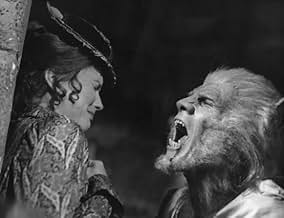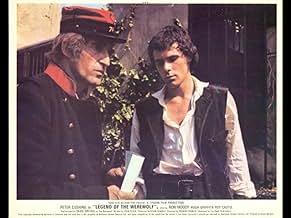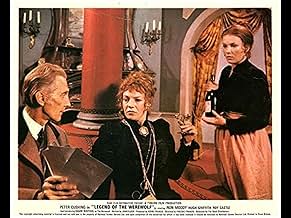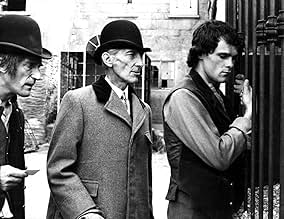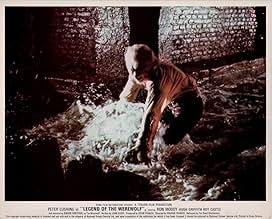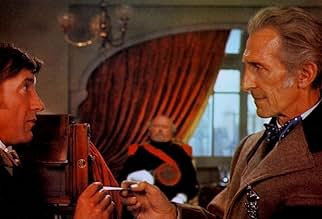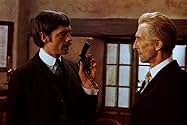CALIFICACIÓN DE IMDb
5.6/10
1 k
TU CALIFICACIÓN
Un circo ambulante en la Francia del siglo diecinueve adopta y exhibe un "niño lobo", que crece hasta la edad adulta solo para matar.Un circo ambulante en la Francia del siglo diecinueve adopta y exhibe un "niño lobo", que crece hasta la edad adulta solo para matar.Un circo ambulante en la Francia del siglo diecinueve adopta y exhibe un "niño lobo", que crece hasta la edad adulta solo para matar.
- Dirección
- Guionista
- Elenco
Renee Houston
- Chou-Chou
- (as Renée Houston)
Hilary Farr
- Zoe
- (as Hilary Labow)
- Dirección
- Guionista
- Todo el elenco y el equipo
- Producción, taquilla y más en IMDbPro
Opiniones destacadas
Hammer Studios provided the BEST horror films for nearly two decades but sputtered out of production near the mid-seventies. What were all those Hammer folk to do? Well, Tyburn Studios utilized many of them in two of their films: The Ghoul & The Legend of the Werewolf. This production has at its directorial helm Hammer stalwart Freddie Francis, actor and Hammer star Peter Cushing, Hammer character actor supreme Michael Ripper, Hammer make-up artist Roy Baker, and scriptwriter Anthony Hinds under the name John Elder. The movie has all the ingredients to be a Hammer success but falls decidedly short. The budget on the film seems to be one of the biggest problems. The special effects are reminiscent of Curse of the Werewolf but seem to lack the craftsmanship of that film(over a decade made). Why? Wasn't Baker the same fellow that made COTW's make-up? The only answer must be budget. The biggest problem for me is the script. Anthony Hinds, who by the way also wrote the script for COTW, just doesn't seem to get any real continuity in the script. The story tells of a "wolf" boy who is picked up by a traveling showman(played very nicely I might add by Hugh Griffith). The boy befriends these people and we advance say some six-ten years and find him traveling with his newly-found friends as a young adult. The moon is full and some wolves bay - and presto chango he turns into a werewolf. This was the first time there had been a full moon in six-ten years? I just found much of what Hinds was trying to do very forced. The film begins also with a red tint to show what the wolf sees. An innovative idea but better employed in films like Wolfen. The film, despite its relatively cheap budget, does have some plusses. Peter Cushing gives a very good performance(when does he not?)as a police surgeon/detective who seems to be the only person working in the city of Paris with any brains. Cushing has some fine moments and seems to really be enjoying his role. In one scene he eats his lunch while reviewing a newly-fresh corpse. Another good scene is his interplay with a madam of a neighborhood whore-house. Always the master of props, Cushing "plays" with a frilly garter the whole scene. Ron Moody as a nasty, dirty zoo keeper also shines in his role. Despite all its efforts to be like Hammer, the film does indeed fall short of those lofty expectations - which is unfortunate given all the Hammer personnel involved. Nonetheless the film is an enjoyable ninety minutes even though it neither adds or detracts anything to the lycanthrope sub-genre.
The Legend of The Werewolf was produced by Tyburn productions, the same people who made 1975's The Ghoul, also with Peter Cushing. Although many involved in the making of these films have been associated with the House of Hammer, it is obvious that Tyburn was a poor imitation for Hammer. Which is not to say Legend of The Werewolf is not entertaining. Indeed, the presence of Peter Cushing alone makes it interesting to horror buffs such as myself. Many films of this ilk are surprisingly hard to find today and valuable to collectors. My copy, distributed by Interglobal Home video, was purchased many years ago and today is next to impossible to find. Interglobal had the distinction for a time in the late 1980's and early 90's for making available films such as these and for that we owe them a considerable debt. Legend of The Werewolf covers no new ground and few surprises. A baby is left for dead and is raised among the wild animals. A few years pass and he is rescued by a traveling carney and spends the rest of his youth performing as "Wolfboy." Finally he embarks out on his own and goes to work as a zookeeper in Paris. Murders begin to happen and Peter Cushing, a medical examiner dabbling in detective work, begins to piece the mystery together. Regrettably, the finale holds little in the way of surprise and is anything but shocking or mysterious. Production values are acceptable given the low budget constraints but one is aware that the House of Hammer could have done much better with similar resources. One bright spot other than Cushing's presence is Ron Moody as the seedy head zookeeper. What a sleazebag! The plotline is fairly creative as a house of ill repute is used to frame the story of the murders and "animal" attacks. Our wolfman's love interest is a prostitute whom he has sadly placed on a pedestal of virtue. Ah well - even low budget B flicks contain their poignant moments of human frailty. If you are a fan of Peter Cushing, obscure horror films, or both, this is required viewing. If you are neither you may not wish to bother. Still, when I viewed this film recently after having not seen it for several years, I enjoyed it much more than I thought I would.
Legend of the Werewolf was released by the Tyburn production company, who only released a handful of horror films during the mid-seventies. It's obvious that the studio was trying to imitate the successful Hammer films, and indeed they've succeeded in capturing the right style as Legend of the Werewolf looks and feels like a Hammer movie, and the company have even managed to get prolific Hammer director Freddie Francis on board, as well as one of the heavyweights of horror; Peter Cushing. The obvious film to compare this one to is the sixties classic 'Curse of the Werewolf', and indeed the two films share a lot of plot elements in common. The film takes place in 19th century France, and focuses on a young boy who was kidnapped and brought up by wolves. Naturally, it's not long before the circus roll into town and spots this boy. He soon becomes the main attraction at the circus, and in spite of this; he manages to grow into a strapping young man. However, the wolf in him soon comes to surface and he begins to rampage through the local population.
Despite capturing the right atmosphere, this film isn't as good as the best that Hammer has to offer. The plot simply isn't all that interesting, and the film doesn't manage to capture that mini epic feel of the earlier Hammer classic. The plot is also rather mundane and if you've seen more than a handful of werewolf movies, you're likely to have already seen all that this film has to offer. Not even Peter Cushing manages to lift this above the mundane in genre terms, as his performance here doesn't feature his usual enthusiasm, and is really just a variation on his classic portrayal of vampire hunter Van Helsing. Cushing starred in a handful of low budget films in the seventies in which he barely had any screen time, and I'm pleased to say that here he features quite prominently. The plot line is more than a little bit stretched, and the film suffers quite often because of this. Simply put; there isn't enough distraction from the central plot idea. Overall, however, this film adequately provides ninety minutes of entertainment, and even though it can't stand up to most of Hammer's films; I did enjoy watching it.
Despite capturing the right atmosphere, this film isn't as good as the best that Hammer has to offer. The plot simply isn't all that interesting, and the film doesn't manage to capture that mini epic feel of the earlier Hammer classic. The plot is also rather mundane and if you've seen more than a handful of werewolf movies, you're likely to have already seen all that this film has to offer. Not even Peter Cushing manages to lift this above the mundane in genre terms, as his performance here doesn't feature his usual enthusiasm, and is really just a variation on his classic portrayal of vampire hunter Van Helsing. Cushing starred in a handful of low budget films in the seventies in which he barely had any screen time, and I'm pleased to say that here he features quite prominently. The plot line is more than a little bit stretched, and the film suffers quite often because of this. Simply put; there isn't enough distraction from the central plot idea. Overall, however, this film adequately provides ninety minutes of entertainment, and even though it can't stand up to most of Hammer's films; I did enjoy watching it.
This was among my earliest recollections of watching a horror film, which occurred in the early 80s via a local TV broadcast (when my family still had a black-and-white set); therefore, I was very much looking forward to re-acquainting myself with it - though, as it doesn't seem to have much of a reputation, it's proved virtually impossible to find until now!
Anyway, I'm glad to say that I liked it quite a bit still: in essence, it's a revamping of Hammer Films' CURSE OF THE WEREWOLF (1961) - by the same writer, John Elder (aka Anthony Hinds), no less - but made this time for the short-lived Tyburn company. The script, in fact, returns the story to its original Paris setting - CURSE having been inspired by Guy Endore's "The Werewolf Of Paris" - and again pits our hirsute hero in the midst of a complicated romantic attachment (a prostitute rather than a merchant's daughter) whose development (the girl is unwilling to give up her profession at first) could or could not control his affliction; still, this element isn't quite as well integrated into the narrative here as it was in the Hammer version - and the decision to allow the lycanthrope to speak briefly, WEREWOLF OF London (1935)-style, was perhaps a mistake. Of course, the film features several other Hammer alumni - director Francis, composer Harry Robinson and, from the cast, Peter Cushing and Michael Ripper (in a cameo as a tramp and one of the werewolf's victims).
The visibly reduced budget allows for little real period atmosphere - despite traveling show, zoo and brothel - but the film is pacy and enjoyable enough to overcome such limitations; still, the werewolf scenes aren't exactly inspired - resorting mainly to either red-tinted POV shots (which, obviously, didn't register during my first viewing of the film) or close-ups of its bare and bloodied fangs - and, while I've always been partial to the silver-haired make-up myself, it's only seen in full at the very end (much like CURSE OF THE WEREWOLF, actually)!
David Rintoul offers no real challenge to Lon Chaney Jr.'s definitive werewolf - or Oliver Reed from CURSE, for that matter; in fact, the most notable cast members are the three top-billed veterans: Hugh Griffith is the owner of the traveling show who raises the wolf-boy (though he disappears from the narrative after the first 20 minutes or so) and Ron Moody plays the eccentric zoo-keeper who employs Rintoul (and whose grounds are used as recreation area by the prostitutes, which is how the young man meets his beloved!), but the film truly belongs to Cushing as the unflappable police surgeon - I've rarely seen him so relaxed (particularly during this latter phase of his career) and he's clearly enjoying every minute of it...though his character gradually turns sleuth and, ultimately, bent on 'treating' Rintoul rather than capturing him (but such radical ideas are not shared by his convention-bound colleagues).
The film also generates some tension during Rintoul's confrontation scenes with his girl's madame (at one point, he even breaks into the brothel through a window to assault a client), as well as the climax set in the Paris sewers (which had allowed the werewolf to move about without being seen).
Anyway, I'm glad to say that I liked it quite a bit still: in essence, it's a revamping of Hammer Films' CURSE OF THE WEREWOLF (1961) - by the same writer, John Elder (aka Anthony Hinds), no less - but made this time for the short-lived Tyburn company. The script, in fact, returns the story to its original Paris setting - CURSE having been inspired by Guy Endore's "The Werewolf Of Paris" - and again pits our hirsute hero in the midst of a complicated romantic attachment (a prostitute rather than a merchant's daughter) whose development (the girl is unwilling to give up her profession at first) could or could not control his affliction; still, this element isn't quite as well integrated into the narrative here as it was in the Hammer version - and the decision to allow the lycanthrope to speak briefly, WEREWOLF OF London (1935)-style, was perhaps a mistake. Of course, the film features several other Hammer alumni - director Francis, composer Harry Robinson and, from the cast, Peter Cushing and Michael Ripper (in a cameo as a tramp and one of the werewolf's victims).
The visibly reduced budget allows for little real period atmosphere - despite traveling show, zoo and brothel - but the film is pacy and enjoyable enough to overcome such limitations; still, the werewolf scenes aren't exactly inspired - resorting mainly to either red-tinted POV shots (which, obviously, didn't register during my first viewing of the film) or close-ups of its bare and bloodied fangs - and, while I've always been partial to the silver-haired make-up myself, it's only seen in full at the very end (much like CURSE OF THE WEREWOLF, actually)!
David Rintoul offers no real challenge to Lon Chaney Jr.'s definitive werewolf - or Oliver Reed from CURSE, for that matter; in fact, the most notable cast members are the three top-billed veterans: Hugh Griffith is the owner of the traveling show who raises the wolf-boy (though he disappears from the narrative after the first 20 minutes or so) and Ron Moody plays the eccentric zoo-keeper who employs Rintoul (and whose grounds are used as recreation area by the prostitutes, which is how the young man meets his beloved!), but the film truly belongs to Cushing as the unflappable police surgeon - I've rarely seen him so relaxed (particularly during this latter phase of his career) and he's clearly enjoying every minute of it...though his character gradually turns sleuth and, ultimately, bent on 'treating' Rintoul rather than capturing him (but such radical ideas are not shared by his convention-bound colleagues).
The film also generates some tension during Rintoul's confrontation scenes with his girl's madame (at one point, he even breaks into the brothel through a window to assault a client), as well as the climax set in the Paris sewers (which had allowed the werewolf to move about without being seen).
I fall into the first category: anything with lycanthropy, I'm THERE! Peter Cushing is fantastic in this film. My particular favorite line he does as a throwaway, looking at a fresh corpse, "Oh, yes, that is VERY nasty." The red lens was a great idea, used effectively in its first scene, then poorly in every scene following. You don't really get a good look at the werewolf til two-thirds into the film and that's for the best. The time- lapse transformation scene starts out great, the next to last shot looks menacing and feral and you wish it'd stop there, then finishes with this silvery-white helmet head look that is nothing short of ludicrous looking in this, the revelatory scene.
The film is not without pathos, however. As an animal lover, I couldn't help but feel pity for Etoil as he was forced to beat one of the wolves in his zoo to death. And, you Hammer elitists out there, you cannot deny that the final sequence with Etoil and Christine is moving and poignantly tragic. Crawling through the sewers weezing "Christine...Christine...".
I confess: I own this on VHS, '87 Interglobal release. I got it when I was 8 and obsessed with werewolves, and I watched it constantly. Every other year or so, I pop it in and I'm not terribly disappointed. Not good, but better than a few Hammer films. So there.
The film is not without pathos, however. As an animal lover, I couldn't help but feel pity for Etoil as he was forced to beat one of the wolves in his zoo to death. And, you Hammer elitists out there, you cannot deny that the final sequence with Etoil and Christine is moving and poignantly tragic. Crawling through the sewers weezing "Christine...Christine...".
I confess: I own this on VHS, '87 Interglobal release. I got it when I was 8 and obsessed with werewolves, and I watched it constantly. Every other year or so, I pop it in and I'm not terribly disappointed. Not good, but better than a few Hammer films. So there.
¿Sabías que…?
- TriviaThis was Renee Houston's final film before her death on February 9, 1980 at the age of 77.
- ErroresAt c. 23 minutes the freshly opened champagne has negligible fizz when it is poured.
- Citas
Prof. Paul: He's all right; he won't harm you, but you musn't reject him!
- ConexionesFeatured in Peter Cushing: A One-Way Ticket to Hollywood (1989)
Selecciones populares
Inicia sesión para calificar y agrega a la lista de videos para obtener recomendaciones personalizadas
- How long is Legend of the Werewolf?Con tecnología de Alexa
Detalles
- Fecha de lanzamiento
- País de origen
- Idioma
- También se conoce como
- Legend of the Werewolf
- Locaciones de filmación
- Productora
- Ver más créditos de la compañía en IMDbPro
- Tiempo de ejecución1 hora 25 minutos
- Mezcla de sonido
- Relación de aspecto
- 1.85 : 1
Contribuir a esta página
Sugiere una edición o agrega el contenido que falta

Principales brechas de datos
By what name was El hombre lobo (1975) officially released in Canada in English?
Responda
